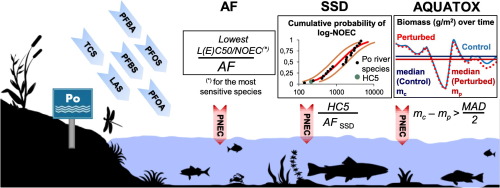Environment International ( IF 10.3 ) Pub Date : 2018-06-20 , DOI: 10.1016/j.envint.2018.06.017 Andrea Gredelj , Alberto Barausse , Laura Grechi , Luca Palmeri

|
Over the past decades, per- and polyfluoroalkyl substances (PFASs) found in environmental matrices worldwide have raised concerns due to their toxicity, ubiquity and persistence. A widespread pollution of groundwater and surface waters caused by PFASs in Northern Italy has been recently discovered, becoming a major environmental issue, also because the exact risk for humans and nature posed by this contamination is unclear. Here, the Po River in Northern Italy was selected as a study area to assess the ecological risk posed by perfluoroalkyl acids (PFAAs), a class of PFASs, considering the noticeable concentration of various PFAAs detected in the Po waters over the past years. Moreover, the Po has a large environmental and socio-economic importance: it is the largest Italian river and drains a densely inhabited, intensely cultivated and heavily industrialized watershed. Predicted no-effect concentrations (PNECs) were derived using two regulated methodologies, assessment factors (AFs) and species sensitivity distribution (SSD), which rely on published ecotoxicological laboratory tests. Results were compared to those of a novel methodology using the mechanistic ecosystem model AQUATOX to compute PNECs in an ecologically-sound manner, i.e. considering physical, chemical, biological and ecological processes in the river. The model was used to quantify how the biomasses of the modelled taxa in the river food web deviated from natural conditions due to varying inputs of the chemicals. PNEC for each chemical was defined as the lowest chemical concentration causing a non-negligible yearly biomass loss for a simulated taxon with respect to a control simulation. The investigated PFAAs were Perfluorooctanoic acid (PFOA) and Perfluorooctanesulfonic acid (PFOS) as long-chained compounds, and Perfluorobutanoic acid (PFBA) and Perfluorobutanesulfonic acid (PFBS) as short-chained homologues. Two emerging contaminants, Linear Alkylbenzene Sulfonate (LAS) and triclosan, were also studied to assess the performance of the three methodologies for chemicals whose ecotoxicology and environmental fate are well-studied. The most precautionary approach was the use of AFs generally followed by SSD and then AQUATOX, except for PFOS, for which AQUATOX yielded a much lower PNEC compared to the other approaches since, unlike the other two methodologies, it explicitly simulates sublethal toxicity and indirect ecological effects. Our findings highlight that neglecting the role of ecological processes when extrapolating from laboratory tests to ecosystems can result in under-protective threshold concentrations for chemicals. Ecosystem models can complement existing laboratory-based methodologies, and the use of multiple methods for deriving PNECs can help to clarify uncertainty in ecological risk estimates.
中文翻译:

使用三种方法得出意大利Po河中新兴污染物的预测无影响浓度(PNEC):评估因子,物种敏感度分布和AQUATOX生态系统建模
在过去的几十年中,由于其毒性,普遍性和持久性,在全球环境基质中发现的全氟和多氟烷基物质(PFAS)引起了人们的关注。最近发现,在意大利北部,PFAS造成了广泛的地下水和地表水污染,这已成为一个主要的环境问题,也是因为这种污染对人类和自然造成的确切风险尚不清楚。在这里,考虑到过去几年在波水域中检测到的各种PFAA的显着浓度,意大利北部的Po河被选为研究区域,以评估一类PFAS全氟烷基酸(PFAA)带来的生态风险。此外,大埔具有重要的环境和社会经济意义:它是意大利最大的河流,流经人口稠密的人流,集约化和高度工业化的分水岭。预测的无效应浓度(PNEC)使用两种受管制的方法得出,即评估因子(AFs)和物种敏感性分布(SSD),它们依赖于已发表的生态毒理学实验室测试。将结果与使用机械生态系统模型AQUATOX以生态合理的方式(即考虑河流中的物理,化学,生物和生态过程)计算PNEC的新方法的结果进行了比较。该模型用于量化河流中模拟分类单元的生物量 将结果与使用机械生态系统模型AQUATOX以生态合理的方式(即考虑河流中的物理,化学,生物和生态过程)计算PNEC的新方法的结果进行了比较。该模型用于量化河流中模拟分类单元的生物量 将结果与使用机械生态系统模型AQUATOX以生态合理的方式(即考虑河流中的物理,化学,生物和生态过程)计算PNEC的新方法的结果进行了比较。该模型用于量化河流中模拟分类单元的生物量食物网由于化学物质的输入变化而偏离自然条件。每种化学品的PNEC定义为导致相对于对照模拟而言,模拟分类群的年度生物量损失不可忽略的最低化学品浓度。研究的PFAA是全氟辛酸(PFOA)和全氟辛烷磺酸(PFOS)作为长链化合物,以及全氟丁酸(PFBA)和全氟丁烷磺酸(PFBS)作为短链同源物。还研究了两种新兴污染物线性烷基苯磺酸盐(LAS)和三氯生,以评估三种方法的化学毒理学性能。对环境的命运进行了深入研究。最为预防的方法是先使用AF,然后使用SSD,然后使用AQUATOX,除了PFOS,与其他方法相比,AQUATOX产生的PNEC比其他方法低得多,因为与其他两种方法不同,它明确地模拟了亚致死毒性和间接生态学效果。我们的研究结果突出表明,从实验室测试推断到生态系统时忽略生态过程的作用可能会导致化学品的保护浓度阈值不足。生态系统模型可以补充现有的基于实验室的方法,并且使用多种方法来推导PNEC可以帮助澄清生态风险估计中的不确定性。











































 京公网安备 11010802027423号
京公网安备 11010802027423号